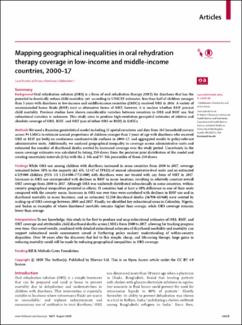Mapping geographical inequalities in oral rehydration therapy coverage in low-income and middle-income countries, 2000–17
Date
2020-08-01Author
Wiens, Kirsten E
Lindstedt, Paulina A
Blacker, Brigette F
Johnson, Kimberly B
Baumann, Mathew M
Schaeffer, Lauren E
Abbastabar Sr, Hedayat
Abd-Allah, Foad
Abdelalim, Ahmed
Abdollahpour, Ibrahim
Hussein Abegaz, Kedir
Negesse Abejie, Ayenew
Guimarães Abreu, Lucas
Abrigo, Michael RM
Abualhasan, Ahmed
Kokou Accrombessi, Manfred Mario
Acharya, Dilaram
Adabi, Maryam
Adamu, Abdu A
Adebayo, Oladimeji M
Adedoyin Sr, Rufus Adesoji
Adekanmbi, Victor
Adetokunboh Sr, Olatunji O
Meressa Adhena, Beyene
Afarideh, Mohsen
Ahmad, Sohail
Ahmadi, Keivan
Ahmed, Anwar E
Beshir Ahmed, Muktar
Ahmed, Rushdia
Yihunie Akalu, Temesgen
Alahdab, Fares
Al-Aly, Ziyad
Alam Sr, Noore
Alam, Samiah
Melak Alamene, Genet
Alanzi, Turki M
Alcalde-Rabanal, Jacqueline Elizabeth
Abdulqadir Ali, Beriwan
Alijanzadeh, Mehran
Alipour, Vahid
Aljunid, Syed Mohamed
Almasi Sr, Ali
Almasi-Hashiani, Amir
Al-Mekhlafi, Hesham M
Altirkawi, Khalid A
Alvis-Guzman, Nelson
Alvis-Zakzuk, Nelson J
Amini Sr, Saeed
Maever Amit Sr, Arianna L
Andrei Sr, Catalina Liliana
Anjomshoa, Mina
Anoushiravani Sr, Amir
Ansari, Fereshteh
Abelardo Antonio, Carl T
Antony, Benny
Antriyandarti, Ernoiz
Arabloo, Jalal
Amin Aref Sr, Hany Mohamed
Aremu, Olatunde
Armoon, Bahram
Arora Sr, Amit
Aryal, Krishna K
Arzani, Afsaneh
Asadi-Aliabadi, Mehran
Tasew Atalay, Hagos
Athari Sr, Seyyed Shamsadin
Masoume Athari, Seyyede
Atre, Sachin R
Ausloos, Marcel
Awoke, Nefsu
Ayala Quintanilla, Beatriz Paulina
Ayano, Getinet
Ayanore Sr, Martin Amogre
Aynalem IV, Yared Asmare
Azari, Samad
Azzopardi, Peter S
Babaee, Ebrahim
Kayode Babalola, Tesleem
Badawi Sr, Alaa
Bairwa, Mohan
Bakkannavar, Shankar M
Balakrishnan, Senthilkumar
Geleto Bali, Ayele
Banach Sr, Maciej
Mattar Banoub Sr, Joseph Adel
Barac, Aleksandra
Bärnighausen, Till Winfried
Basaleem, Huda
Basu, Sanjay
Bay, Vo Dinh
Bayati, Mohsen
Baye, Estifanos
Bedi, Neeraj
Beheshti, Mahya
Behzadifar, Masoud
Behzadifar, Meysam
Begashaw Bekele, Bayu
Muche Belayneh, Yaschilal
Bell Sr, Michellr L
Bennett Sr, Derrick A
Ajema Berbada, Dessalegn
Bernstein, Robert S
Bhat Sr, Anusha Ganapati
Bhattacharyya Sr, Krittika
Bhattarai, Suraj
Bhaumik, Soumyadeep
Bhutta, Zulfiqar A
Bijani, Ali
Bikbov, Boris
Birihane IV, Binyam Minuye
Kishore Biswas, Raaj
Bohlouli, Somayeh
Amensisa Bojia, Hunduma
Boufous, Soufiane
Brady, Oliver J
Bragazzi, Nicola Luigi
Briko, Andrey Nikolaevich
Briko, Nikolay Ivanovich
Britton, Gabrielle B
Nagaraja Sr, Sharath Burugina
Busse Sr, Reinhard
Butt, Zahid A
Cámera Sr, Luis LA Alberto
Campos-Nonato Sr, Ismael R
Cano, Jorge
Car, Josip
Cárdenas, Rosario
Carvalho Sr, Felix
Castañeda-Orjuela Sr, Carlos A
Castro, Franz
Chanie Sr, Wagaye Fentahun
Chatterjee, Pranab
Chattu, Vijay Kumar
Chichiabellu Jr, Tesfaye Yitna
Chin Sr, Ken Lee
Christopher, Devasahayam J
Chu, Dinh-Toi
Cormier, Natalie Maria
Costa, Vera Marisa
Culquichicon, Carlos
Soboka Daba, Matiwos
Damiani Sr, Giovanni
Dandona, Lalit
Dandona, Rakhi
Dang, Anh Kim
Darwesh, Aso Mohammad
Darwish, Amira Hamed
Daryani Sr, Ahmad
Das, Jai K
Metadata
Show full item recordAbstract
Background Oral rehydration solution (ORS) is a form of oral rehydration therapy (ORT) for diarrhoea that has the potential to drastically reduce child mortality; yet, according to UNICEF estimates, less than half of children younger than 5 years with diarrhoea in low-income and middle-income countries (LMICs) received ORS in 2016. A variety of recommended home fluids (RHF) exist as alternative forms of ORT; however, it is unclear whether RHF prevent child mortality. Previous studies have shown considerable variation between countries in ORS and RHF use, but subnational variation is unknown. This study aims to produce high-resolution geospatial estimates of relative and absolute coverage of ORS, RHF, and ORT (use of either ORS or RHF) in LMICs.
Methods We used a Bayesian geostatistical model including 15 spatial covariates and data from 385 household surveys across 94 LMICs to estimate annual proportions of children younger than 5 years of age with diarrhoea who received ORS or RHF (or both) on continuous continent-wide surfaces in 2000–17, and aggregated results to policy-relevant administrative units. Additionally, we analysed geographical inequality in coverage across administrative units and estimated the number of diarrhoeal deaths averted by increased coverage over the study period. Uncertainty in the mean coverage estimates was calculated by taking 250 draws from the posterior joint distribution of the model and creating uncertainty intervals (UIs) with the 2·5th and 97·5th percentiles of those 250 draws.
Findings While ORS use among children with diarrhoea increased in some countries from 2000 to 2017, coverage remained below 50% in the majority (62·6%; 12 417 of 19 823) of second administrative-level units and an estimated 6 519 000 children (95% UI 5 254 000–7 733 000) with diarrhoea were not treated with any form of ORT in 2017. Increases in ORS use corresponded with declines in RHF in many locations, resulting in relatively constant overall ORT coverage from 2000 to 2017. Although ORS was uniformly distributed subnationally in some countries, within-country geographical inequalities persisted in others; 11 countries had at least a 50% difference in one of their units compared with the country mean. Increases in ORS use over time were correlated with declines in RHF use and in diarrhoeal mortality in many locations, and an estimated 52 230 diarrhoeal deaths (36 910–68 860) were averted by scaling up of ORS coverage between 2000 and 2017. Finally, we identified key subnational areas in Colombia, Nigeria, and Sudan as examples of where diarrhoeal mortality remains higher than average, while ORS coverage remains lower than average.
Interpretation To our knowledge, this study is the first to produce and map subnational estimates of ORS, RHF, and ORT coverage and attributable child diarrhoeal deaths across LMICs from 2000 to 2017, allowing for tracking progress over time. Our novel results, combined with detailed subnational estimates of diarrhoeal morbidity and mortality, can support subnational needs assessments aimed at furthering policy makers' understanding of within-country disparities. Over 50 years after the discovery that led to this simple, cheap, and life-saving therapy, large gains in reducing mortality could still be made by reducing geographical inequalities in ORS coverage.

